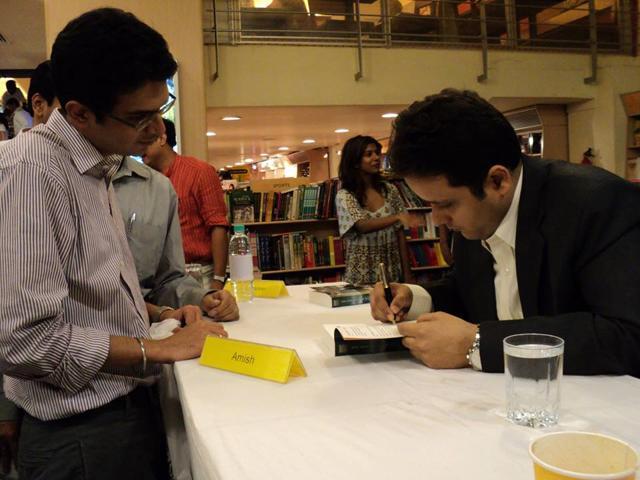Here’s what makes Amish Tripathi a progressive mythologist
Amish Tripathi’s second book in the Ram Chandra series, Sita – Warrior of Mithila, is set to release soon. And by drawing from India’s vast, liberal past, the author hopes to make a case for issues ranging from women’s empowerment to greater inclusivity.
A quick Google search for Amish Tripathi throws up nearly 4 lakh results. But it’s his social media pages where all the frenzy is — there are questions, discussions, tons of videos and even photos of tattoos (from his Shiva series) sent in by fans. And Tripathi is in the thick of it all — practically every post on Facebook (over 720K followers) gets a reply, there are amiable discussions with followers on Twitter (633K followers), and he’s even running a contest inviting five alternative cover designs for his upcoming book, Sita — Warrior of Mithila. Clearly, the man has nailed the social media game.

But Tripathi surprises us by calling the cell phone “the biggest destroyer of productivity”. “We live in such a hyper-communicated world today and are so distracted. Actually, I’m more active [on social media] when I have a book coming out. Otherwise, my core job is to read and write,” he says.
Tripathi has written four best-selling novels in five years, and his fifth, Sita — the second in the Ram Chandra series — is set to release by the end of May. So, while he agrees that a good book doesn’t sell itself, and marketing is essential, he follows a rough rule of thumb when it comes to writing: read a hundred pages of relevant material for every page you write. “Only then will your book have enough depth. I like to maintain that ratio, so I read a lot of non-fiction... history, economics, politics and science. There are other things you should do too, like attending lit fests, writing articles, or commenting on issues outside your book, but not at the cost of your core,” he emphasises.
READ MORE: A puppet artist is exploring Indian mythology through life-sized puppets
Batting for women
Of the five books in the Ram Chandra series, three follow the multilinear narrative style of storytelling (the third is slated to release next year). The first, Scion of Ikshvaku (2015) is from the birth of Ram to the kidnapping of Sita. Sita — Warrior of Mithila is from the birth of Sita to the kidnapping of Ram. While Scion… takes us through Ram’s journey, it’s his wife who takes centrestage in Sita…. Tripathi is quick to add that she’s not the docile, submissive Sita of popular folklore. She’s a warrior whose weapons include knives and spears. “The impression of Sitadevi, in urban India at least, has been driven by the ’80s TV show (Ramanand Sagar’s Ramayan on Doordarshan). There are many things about her that modern Indians don’t know, like she was found in a field and adopted by king Janaka and queen Sunaina. What kind of strength of character it must take for an adopted child to become a warrior, a prime minister, and a goddess, as she is remembered today.” he says.

Tripathi’s book, particularly his portrayal of Sita, comes at an interesting time in India — when women’s empowerment has become a political minefield. We point this out to him, and he says that most of the modern versions of our stories are based on medieval interpretations. “In our ancient versions, you’ll find that women had a far stronger role. There are women rishis like Ma Rishika Maitriyi, Lopamudra and Gargi who contributed to the Rig Veda, our oldest scripture. The status of the rishis who wrote it was higher than even the kings. So a woman rishi was the equivalent of a female prophet or a messiah,” he says, pausing to add, “That was the status of women in ancient India. We need to revive and celebrate that. If you want to speak about women’s empowerment, there’s a greater likelihood of having an impact if we say that it’s actually a part of our ancient culture, rather than saying that it’s part of westernisation.”
A liberal past
Responding to a follower’s query on Twitter recently, Tripathi said that India’s ancient culture is the best guarantor of liberalism. In an increasingly hostile Left vs Right political climate, it’s an issue the former banker is passionate about. Talking about the caste system, he points out an interesting aspect to Valmiki, who wrote the original Ramayana. “Was he born a Brahmin? No. Ved Vyas’ original name was Krishna Dwepayan and he was born to a fisherwoman. Lord Ram’s officiating priest was the son of a single Shudra mother. And nobody cared. If we actually teach our ancient culture as part of our education system, we won’t even have to argue points like liberalism or equality. Of course women were treated as equals. They wrote the scriptures, yaar.”
In the race for greater progress and global recognition, it’s these aspects of ancient culture the author hopes we direct our attention to. For instance, the inclusion of our literature, sciences and mathematics in the education system could be a starting point. “In medical college, you start with the works of Hippocrates, a great medicine man. But why not Charak or Sushruta? And people wonder ‘we didn’t know our past was liberal’. You’re not allowing them to learn.”
READ MORE: A new book reinvents Draupadi as a party animal
Given his massive fan following that transcends borders (his books have been translated into Polish, Turkish and Spanish), it’s safe to say that Tripathi is a ‘literary popstar’, as director Shekhar Kapur once called him. But when it comes to the critical acclaim-versus-mass popularity debate, Amish has a different view of success.
He references Jane Austen, who was disliked by critics in her era, but went on to have a long-term impact on the women’s empowerment movement. “The only true judge of a book’s quality is time. The shuddh Hindi word for a classic is kaaljayee: that which defeats time. When you’re writing, you shouldn’t think of being a best-seller or of critical approval. You should just write what feels right to you. No author can be sure whether his book will survive or not.”
Must-read
What: Sita — Warrior of Mithila, by Amish, will be out in May. Pre-order it on Amazon India at a discounted price of Rs 248.
Publisher: Westland Books
Price: Rs 350





